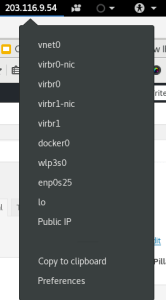I’ve been using Fedora ever since it came out back in 2003. The developers of Fedora and the greater community of contributors have been doing a amazing job in incorporating features and functionality that subsequently has found its way into the downstream Red Hat Enterprise Linux distributions.
There are lots to cheer Fedora for. GNOME, NetworkManager, systemd and SELinux just to name a few.
Of all the cool stuff, I particularly like to call out three must haves.
a) Pomodoro – A GNOME extension that I use to ensure that I get the right amount of time breaks from the keyboard. I think it is a simple enough application that it has to be a must-have for all. Yes, it can be annoying that Pomodoro might prompt you to stop when you are in the middle of something, but you have the option to delay it until you are done. I think this type of help goes a long way in managing the well-being of all of us who are at our keyboards for hours.
 b) Show IP: I really like this GNOME extension for it does give me at a glance any of a long list of IPs that my system might have. This screenshot shows ten different network end points and the IP number at the top is that of the Public IP of the laptop. While I can certainly use the command “ifconfig”, while I am on the desktop, it is nice to have it needed info tight on the screen.
b) Show IP: I really like this GNOME extension for it does give me at a glance any of a long list of IPs that my system might have. This screenshot shows ten different network end points and the IP number at the top is that of the Public IP of the laptop. While I can certainly use the command “ifconfig”, while I am on the desktop, it is nice to have it needed info tight on the screen.
c) usbguard: My current laptop has three USB ports and one SD card reader. When it is docked, the docking station has a bunch more of USB ports. The challenge with USB ports is that they are generally completely open ports that one can essentially insert any USB device and expect the system to act on it. While that is a convenience, the possibility of abuse is increasing given rogue USB devices such as USB Killer, it is probably a better idea to deny, by default, all USB devices that are plugged into the machine. Fortunately, since 2007, the Linux kernel has had the ability to authorise USB devices on a device by device basis and the tool, usbguard, allows you to do it via the command line or via a GUI – usbguard-applet-qt. All in, I think this is another must-have for all users. It should be set up with default deny and the UI should be installed by default as well. I hope Fedora 27 onwards would be doing that.
increasing given rogue USB devices such as USB Killer, it is probably a better idea to deny, by default, all USB devices that are plugged into the machine. Fortunately, since 2007, the Linux kernel has had the ability to authorise USB devices on a device by device basis and the tool, usbguard, allows you to do it via the command line or via a GUI – usbguard-applet-qt. All in, I think this is another must-have for all users. It should be set up with default deny and the UI should be installed by default as well. I hope Fedora 27 onwards would be doing that.
So, thank you Fedora developers and contributors.
[…] must haves in #Fedora26 https://harishpillay.wordpress.com/2017/07/20/three-must-haves-in-fedora-26/ #f26 #fedora #gnu #linux […]
Btw: You can take screenshots of just one Window by pressing Alt+Print.
Yes indeed. I prefer to select areas that are just outside a window, so I have defined the keys Alt-PrintScreen to allow me to select the areas I need.
[…] Three must haves in Fedora 26 […]
[…] Three must haves in Fedora 26 […]